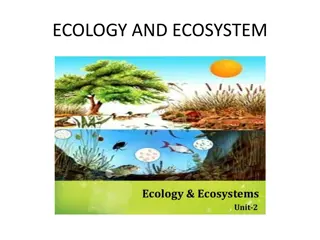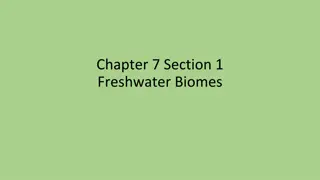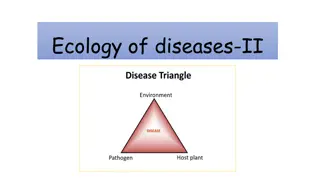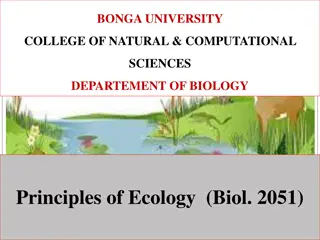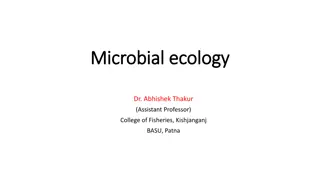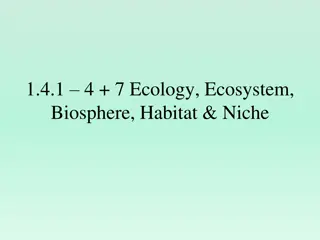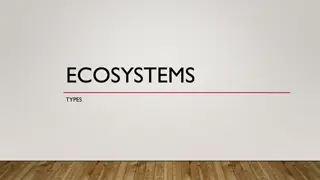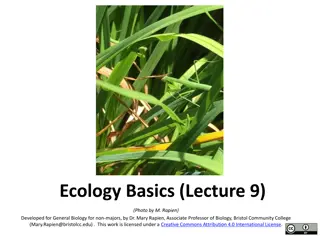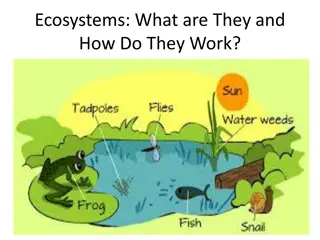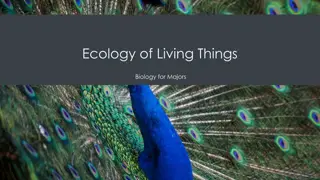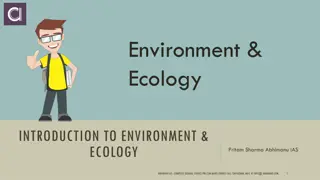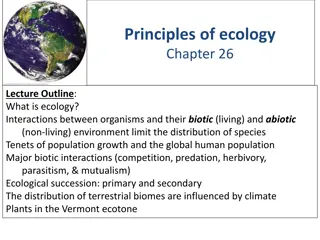Exploring Community Ecology: Interactions in Ecosystems
Community ecology, as presented by Mr. Nitin A. Ghorpade, delves into the dynamics of species interactions within ecosystems. It covers concepts like communities, individualistic vs. interactive hypotheses, interspecific interactions, predation, parasitism, plant defenses against herbivores, and more. Understanding these relationships is vital for comprehending the functioning and stability of natural ecosystems.
Download Presentation

Please find below an Image/Link to download the presentation.
The content on the website is provided AS IS for your information and personal use only. It may not be sold, licensed, or shared on other websites without obtaining consent from the author. Download presentation by click this link. If you encounter any issues during the download, it is possible that the publisher has removed the file from their server.
E N D
Presentation Transcript
Topic :- Community ecology Presented by Mr. Nitin A. Ghorpade Department of Microbiology Deogiri College, Aurangabad 1
Communities A community is a group of organisms of different species that live in a particular area
Individualistic Hypothesis vs. Interactive Hypothesis Individualistic Hypothesis: A community is a chance group of species found in the same area because they have similar abiotic requirements Interactive Hypothesis: A community is a group of closely linked species locked together in mandatory biotic interactions that cause the community to function as an integrated unit
Interspecific Interactions Interspecific interactions are interactions that occur between populations of different species living together in a community There are 4 major interspecific interactions: Predation (and parasitism) Competition Commensalism Mutualism
Predation (and Parasitism) (+ -) The interaction is beneficial to one species and detrimental to the other Predation: When a predator eats its prey Example in picture:
Predation (and Parasitism) Parasitism: Predators that live on or in their hosts, usually feeding off their body tissues or fluids Usually do not kill their hosts Examples:
Plant Defenses Against Herbivores Plants Fight Back! Plants have 2 major mechanisms by which they defend themselves against being eaten Mechanical Defenses Thorns, hooks, etc.
Plant Defenses Against Herbivores Chemical Defenses Produce chemicals that are distasteful or harmful to an herbivore Morphine (opium poppy) Nicotine (tobacco)
Animal Defenses Against Predators Animals defend themselves against predators passively (hiding) or actively (fleeing) Cryptic coloration (camouflage) makes prey difficult to spot
Animal Defenses Against Predation Mimicry When one species imitates or mimics another Batesian mimicry When one edible or harmless species mimics an bad- tasting (unpalatable) or harmful species Example: hawkmoth mimics a snake
Animal Defenses Against Predation Mimicry Mullerian mimicry Two species, both of which are unpalatable (taste bad) or harmful, resemble each other Example: monarch butterfly (unpalatable) and queen butterfly (unpalatable) resemble each other
Parasitism One organism (the parasite) gets its nourishment from another organism (the host), which is harmed in the process Endoparasites: Live within host tissues (tapeworms) Ectoparasites: Feed on external surfaces (mosquitoes)
Interspecific Competition Competition between organisms of different species The Competitive Exclusion Principle: Two species with similar needs for the same limiting resources cannot coexist in the same place
Ecological Niches An organism s niche is the specific role it plays in its environment All of its uses of biotic and abiotic resources in its environment Example: oak tree in a deciduous forest Provides oxygen to plants, animals, etc. Home for squirrels Nesting ground for blue jays Takes water out of the soil Etc., etc.
Commensalism (+0) relationship One partner benefits, the other is not affected Examples: Cattle and cattle egret (birds) Sea anemone and clownfish Clownfish gets a place to live, sea anemone is not affected
Mutualism (++) relationship Both partners benefit from the relationship You scratch my back, I ll scratch yours Examples: Mycorrhizae Plant gets increased water/nutrition, fungi gets food Hummingbirds & flowers Hummingbirds get food, flowers can reproduce
Dominant & Keystone Species Dominant Species: Species in a community that have the highest abundance or highest biomass Sugar maple in eastern North America Keystone Species: Important to a community because of their ecological roles (niches), not by numbers Sea otters control sea urchin population, which controls kelp population
Ecological Succession Ecological succession is a change in the species that live in a given area over a period of time One community replaces another Primary succession = occurs in places where soil is not yet formed Secondary succession = occurs in places where there is soil, but where some disturbance has eliminated the previous community
Ecological Succession The first organisms to inhabit an area undergoing succession are known as pioneer organisms These are usually small organisms (bacteria, lichens, algae, etc.) The ecosystem goes through a number of stages, with each new stage usually consisting of larger organisms than the last one Once a community has become stable and is not changing much, it is known as a climax community
Causes of Ecological Succession There are 3 major causes of ecological succession: 1. Human Activities - logging, mining, development, etc. 3. Natural Disasters/Disturbances - fires, volcanic eruptions, etc. 3. Natural Competition Among Species - Fictitious example: - turtles and frogs both eat crickets - frogs are faster, turtles are slower - frogs eat more crickets, turtles starve - turtle population dies out, frog population gets bigger






